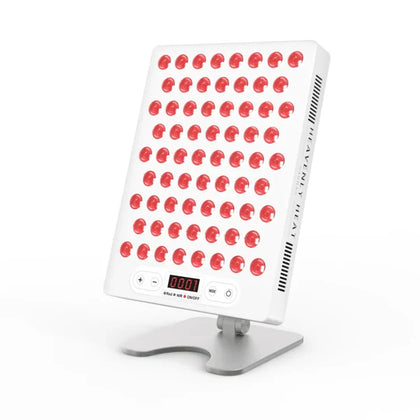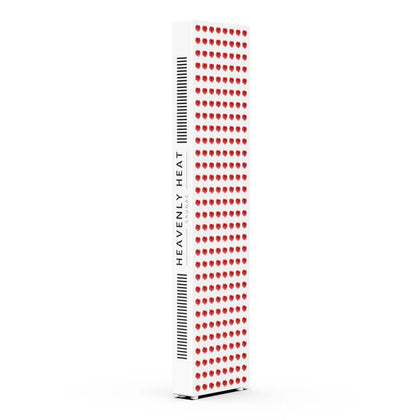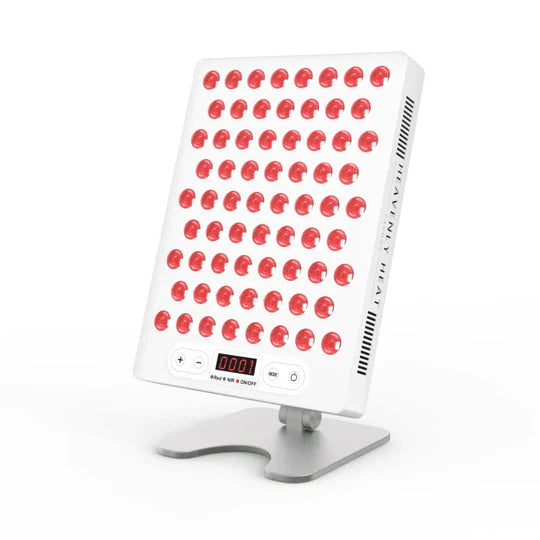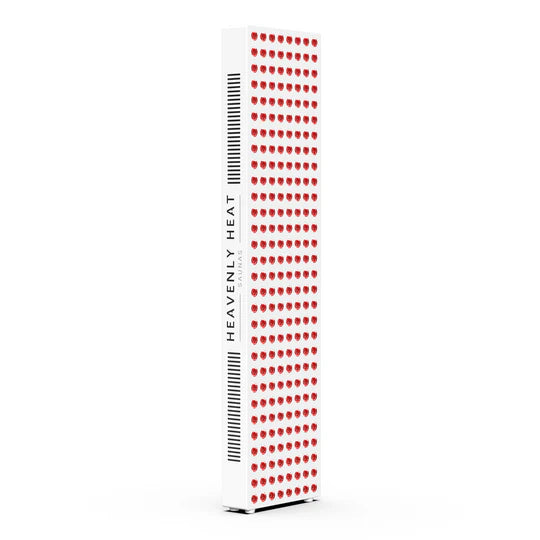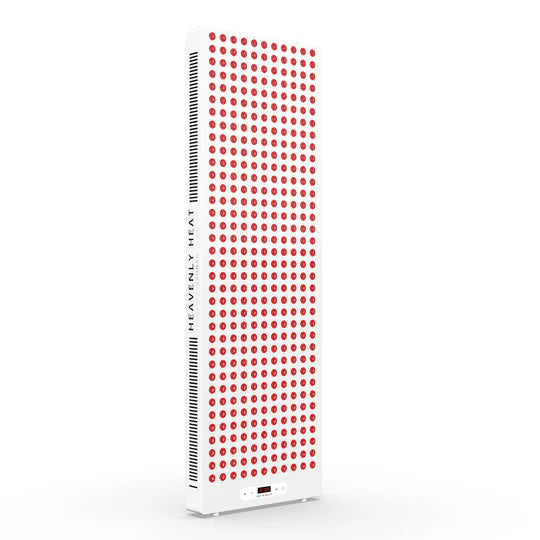Does Red Light Therapy Increase Collagen?

Fatigue, joint pain, and skin rashes, these are just a few symptoms of collagen-related issues that can quietly erode your energy and confidence.
What’s worse? Left unchecked, collagen degradation from autoimmune or genetic collagen vascular diseases may accelerate aging and chronic discomfort.
But what if the solution isn’t in your medicine cabinet, but in a beam of red light? Let’s explore.
Table of contents
Key Takeaways
Boost Collagen Naturally: Use red light therapy to stimulate your skin’s own collagen production.
Improve Skin Firmness: Strengthen elasticity and reduce sagging with consistent treatments.
Target Wrinkles and Texture: Smooth fine lines and refresh dull skin by regenerating collagen fibers.
Choose the Right Wavelength: Combine red and infrared light for both surface and deep collagen benefits.
Stay Consistent for Results: Use red light therapy 3, 5 times a week to see visible improvements in 4, 6 weeks.

THE SCIENCE BEHIND RED LIGHT THERAPY AND COLLAGEN
Red light therapy helps your skin by boosting collagen, which keeps your skin firm and smooth. As we get older or spend too much time in the sun, our skin produces less collagen.
This causes wrinkles, dryness, and sagging. Red and infrared light gently reach deep into your skin and wake up the cells that make collagen and other important proteins like elastin and hyaluronic acid.
In one study with 136 people, researchers found that after 30 sessions of red light treatment, skin looked clearer, felt smoother, and had more collagen.
People felt happier with their skin, and no one had any side effects. Another study showed that even low doses of red and infrared light could boost collagen and other proteins in skin cells in just a few days.
The scientists said this kind of light therapy might be a safe and easy way to help fight signs of aging and sun damage at home.
Remember, red light therapy isn’t a miracle cure, but it can be a helpful boost for your skin’s health. More research will help us understand exactly how well it works over time.
What Is Collagen?
- Collagen Helps Keep Your Body Strong and Flexible: Collagen is essential for maintaining the strength and flexibility of your skin, joints, bones, and muscles, helping them stay firm and healthy.
- Collagen Is Found in Key Parts of Your Body: Collagen is present in your skin, tendons, ligaments, bones, and even teeth. Types I, II, and III are the most common forms.
- Your Body Naturally Produces Collagen: Your body produces collagen using amino acids and important nutrients like vitamin C, which help keep your body strong.
- Aging Slows Down Collagen Production: As you get older, your body’s ability to produce collagen decreases, which can lead to thinner skin, slower healing, and reduced elasticity.
- External Factors Can Accelerate Collagen Breakdown: Factors like UV rays, pollution, and smoking can cause collagen to break down faster, affecting your skin’s strength and flexibility.

Why Collagen Matters for Skin Health?
Collagen Increases Skin Elasticity by Strengthening Structural Support Layers
Collagen strengthens the skin's structural support, particularly the dermis, which helps maintain elasticity and prevent sagging.
The dermis, composed of the papillary layer that extends into the epidermis and the deeper reticular layer, relies on collagen to provide both strength and flexibility, ensuring the skin remains firm yet supple.
It Enhances Skin Hydration by Improving Moisture Retention in Cells
Collagen binds water molecules and helps skin retain moisture. It creates a hydrated environment by supporting the extracellular matrix, which is a network of proteins that supports skin cells and retains moisture.
This holds water and keeps skin soft and smooth. Loss of collagen can lead to dryness and dullness.
Collagen Reduces Wrinkles by Restoring Skin’s Smoothness and Volume
- Collagen fills fine lines to make skin look smoother: As collagen builds up in the skin, it naturally fills in small lines and softens rough texture, making the skin look smoother and more refreshed.
- It brings back lost volume and makes skin look fuller: When skin starts to look hollow or sunken with age, collagen helps by plumping it up again, restoring a younger, healthier appearance.
- Collagen keeps the skin strong so it doesn't sag: By supporting the layers under the skin, collagen helps keep it firm and elastic, which prevents loose or droopy skin.
- It slows down new wrinkles from forming: Collagen not only fixes current wrinkles but also helps stop new ones from appearing by keeping the skin's support system strong over time.
It Accelerates Skin Repair by Stimulating New Cell Growth and Turnover
Collagen supports new cell growth and turnover, helping the skin heal faster and reducing the appearance of scars and blemishes. It plays a key role in regenerating skin and keeping it healthy.
Collagen Protects Against UV Damage by Supporting Antioxidant Defense Mechanisms
Collagen contributes to antioxidant defense by supporting the production of protective molecules that combat oxidative stress from UV exposure and other environmental stressors.
It Promotes a Youthful Glow by Improving Skin Texture and Radiance
Incorporating collagen-rich foods, collagen supplements, or collagen-infused skincare products can help support healthy collagen levels in the skin and promote a glowing, youthful complexion,” says Dr. Ava Shamban, a board-certified celebrity dermatologist.
As collagen production declines, signs of aging like sagging and wrinkles become more visible.
Supporting collagen from both the inside and outside helps combat this loss. Collagen-boosting treatments like red light therapy can help rebuild what’s been lost, restoring firmness and resilience.
Combining lifestyle approaches with proven therapies creates a comprehensive strategy for maintaining youthful, healthy skin as you age.
Common Signs of Collagen Loss in the Skin
Fine Lines and Wrinkles Around Eyes and Mouth from Collagen Decline
- Fine lines start showing up because your skin loses support early on: Collagen production decreases by about 1% each year after your early 20s,” says Dr. Shereene Idriss, a board-certified dermatologist at Union Square Laser Dermatology . This slow loss starts to weaken the skin’s structure, especially in thinner areas like around the eyes and mouth, where fine lines can begin to appear.
- In your 30s, wrinkles around the eyes and mouth become more noticeable: Although you might not see big changes in your 20s, by your late 30s the fine lines and wrinkles become more obvious. This happens because your skin has less collagen to keep it smooth and firm, and the thinner areas show signs first.
- By old age, most of your skin’s collagen is gone, making wrinkles deeper: With time, the damage adds up. Research shows that by the time you're 70, you could lose up to 80% of your collagen and elastin. This leads to deeper wrinkles and sagging, especially around the eyes and mouth where skin is most delicate.
Reduced Skin Elasticity and Firmness Caused by Collagen Breakdown Over Time
- Loss of Collagen Reduces Skin Firmness and Elasticity: When collagen breaks down, skin elasticity and firmness decrease, leading to sagging, especially around the cheeks or jawline.
- Skin Loses Youthful Tone and Becomes Prone to Wrinkles: As collagen weakens further, the skin loses its youthful tone and becomes more prone to wrinkles and sagging.
- Collagen Breakdown Makes Skin Feel Weaker: Collagen loss doesn’t just change how your skin looks; it also makes it feel weaker and less resilient.
- Red Light Therapy Helps Keep Skin Firm: Treatments like red light therapy can slow collagen loss, keeping your skin firm and resilient over time.
Thinning Skin and Visible Veins Due to Collagen Loss in Layers
Collagen depletion in deeper skin layers causes thinning, making veins more visible and skin more fragile.
Dull, Uneven Skin Tone from Slower Cell Turnover Linked to Collagen Loss
Slower cell turnover, the process of replacing old skin cells with new ones, due to low collagen leads to dead cell buildup and uneven pigmentation, creating a tired, patchy look.
Sagging Cheeks and Jawline as Facial Structure Loses Collagen-Based Support
With less collagen to support facial structure, cheeks and jawline begin to sag. This softening of contours is a key sign of aging skin.
Dry and Rough Skin Texture Caused by Weakening Collagen Support System
Without collagen, the skin’s moisture barrier weakens, resulting in dryness, roughness, and reduced smoothness.
Slower Healing of Skin Injuries Due to Reduced Collagen Repair Function
Collagen supports skin regeneration and healing. With less of it, wounds take longer to repair and scars become more pronounced.
Ways Red Light Therapy Boosts Collagen?
Enhanced Collagen Production by Increasing Blood Flow, Oxygen, and Nutrient Delivery
- More blood flow means your skin gets the fuel it needs: Red light therapy increases blood flow and oxygen delivery to your skin cells. This gives them the energy and nutrients required to make more collagen, helping your skin stay firm and youthful. This gentle process is called photobiomodulation.
- Red light gives your skin cells the energy to work better: The light reaches the mitochondria inside your skin cells, where it's turned into ATP, your body’s natural energy. This energy helps cells repair themselves and make collagen faster and more effectively.
- No heat, no damage—just safe and natural skin support: Unlike lasers, red light doesn’t burn or harm your skin. It works without heat, making it safe to use regularly while still helping your skin build collagen naturally over time.
- Regular use makes your skin look smoother and younger: When used consistently, red light therapy keeps skin cells active and boosts collagen production. This helps reduce wrinkles, firm up the skin, and improve overall texture with visible long-term results.
- Real results from people who used it consistently: In one study using a red light mask (Dior x Lucibel at 630 nm), people saw better skin tone, less wrinkle depth, and more firmness after using it twice a week for three months. They were happy with the results, and the improvements lasted even after they stopped using the mask.
Stimulates Fibroblast Cells to Boost Natural Collagen and Elastin Production
- Red light therapy wakes up the cells that build strong, flexible skin: Red light therapy activates fibroblast cells, which are responsible for producing both collagen and elastin,key proteins that maintain the skin’s strength and flexibility.
- These cells also protect the collagen you already have: These fibroblasts also help preserve existing collagen by inhibiting enzymes that break it down, keeping the skin resilient over time.
- This double action makes your skin look firmer and younger: Together, this stimulation and protection lead to firmer, more elastic skin and a visible reduction in the signs of aging.
- Taking collagen can help your skin make more collagen and elastin: Collagen supplements have recently been shown to promote elastin and collagen production in the skin,” says Dr. Harshal, a practicing clinical and aesthetic dermatologist. This insight aligns with how red light therapy works at the cellular level.

Promotes Collagen Remodeling for Smoother, Firmer, and More Youthful Skin
By encouraging the replacement of old collagen with new, healthy fibers, red light therapy helps improve skin texture, firmness, and elasticity.
Improves Skin Elasticity and Firmness by Strengthening Structural Skin Proteins
- Red light makes skin feel firmer by building stronger collagen: One big reason red light therapy works is because it helps make collagen fibers stronger. Collagen is like the skin’s support system, and when it’s stronger, your skin feels tighter and more lifted.
- It helps skin stay bouncy and soft like before: Red light therapy wakes up the cells that make collagen and elastin. These are the proteins that help skin stretch and snap back, like when you smile or move. This gives the skin a soft, bouncy feel, just like younger skin.
- Skin looks less saggy and more lifted with regular use: As more collagen and elastin are built over time, the skin stops drooping as much. You start to notice the skin looks lifted, smoother, and more full of life, reducing that tired or sagging look.
Accelerates Wound Healing and Scar Fading Through Collagen Matrix Support
- Red Light Therapy Builds Collagen for Faster Healing: At injury sites, red light therapy helps build a strong collagen matrix, speeding up tissue repair and providing the structure needed for quicker recovery.
- Collagen Boost Helps Fade Scars: By increasing collagen production, red light therapy helps reduce the appearance of scars, promoting smoother skin as healing progresses.
Reduces Fine Lines and Wrinkles by Stimulating Deep Collagen Regeneration
Deep stimulation from red light therapy regenerates collagen, filling in wrinkles and smoothing skin over time.
Helps Restore Youthful Appearance by Rebuilding Skin’s Collagen Foundation
By rebuilding the skin’s collagen foundation, red light therapy lifts sagging skin and revives its youthful tone and bounce.
Other Therapies that help with Increase Collagen
Near-Infrared (NIR) Light Therapy
Near-Infrared (NIR) light therapy gives your skin a natural boost by reaching deep into the layers where collagen is made.
It helps your cells create more energy and tells your body to make more collagen and elastin, the stuff that keeps your skin firm and smooth.
In one study , people who used red and NIR light saw better skin texture and more collagen after just 30 sessions.
Another study , found the same results in lab tests, showing stronger collagen and more energy in skin cells. It’s a simple, non-invasive way to help your skin look younger.
Blue Light Therapy
Blue light therapy might not get as much attention as red light, but it also helps your skin make more collagen.
It does this by waking up the cells that heal and repair your skin, which is a big part of how collagen gets made.
One review looked at , 22 studies and found that using low doses of blue light helped boost the activity of these skin-repairing cells.
Another study , from Baoji Hospital showed that when people used blue and red light together with a collagen treatment, their skin got healthier, more hydrated, and less inflamed, great signs for collagen support.
Green Light Therapy
Green light therapy is another option worth knowing if you want to boost collagen. It works by protecting your skin from damage caused by UVB rays, the kind that speeds up aging and breaks down collagen.
Green light helps your skin stay younger by boosting the production of collagen types I and III, while also lowering the levels of enzymes that break collagen down.
One study from the Wiley Open Access Collection , found that green light therapy made aging skin cells look and act younger. It even helped stop collagen loss.
This makes green light a smart addition to your routine if you're looking for more ways to support healthy, firm skin.
Wavelengths Used in Red Light Therapy for Collagen Stimulation
- Effective Wavelengths for Collagen Production: Red light therapy is most effective for collagen stimulation with wavelengths ranging from 600 to 900 nm.
- 650 nm Wavelength Boosts Collagen and Reduces Wrinkles: The 650 nm wavelength is especially good at penetrating the skin, helping to produce more collagen and reduce wrinkles.
- Different Wavelengths Target Different Skin Layers: Wavelengths from 600-700 nm affect the skin’s surface, while wavelengths from 800-900 nm reach deeper layers to promote collagen regeneration.
- Longer Wavelengths Help with Deeper Collagen Stimulation: Wavelengths like 850 nm penetrate deeper, stimulating collagen production in connective tissues for overall skin rejuvenation.
- Broader Wavelength Ranges Improve Skin Appearance: Studies show that a range of wavelengths, from 611-650 nm to 570-850 nm, can improve skin roughness and enhance collagen density.
Is Red or Infrared Light Better for Collagen?
Red light is best for surface-level results, like improved texture, glow, and reduced redness, while infrared light penetrates deeper for structural collagen repair. A combination of both offers the most comprehensive benefits.
How Often Should You Use Red Light Therapy to Boost Collagen?
Most people benefit from 3 to 5 sessions per week, each lasting 10–20 minutes. It’s best to stay consistent and allow at least 4 to 6 weeks to notice visible improvements, but if you’re seeing signs like dry skin, fine lines, dullness, or a crepey texture under the eyes, it could mean your current routine needs a slight adjustment.
How Long Does It Take to See Collagen Improvements After Red Light Therapy?
Some skin texture changes may appear after a few sessions, but noticeable collagen-related results typically take 4, 6 weeks. Long-term improvements can be maintained with regular use.
Are There Any Side Effects Related to Collagen Treatment with Red Light?
Red light therapy is generally safe. Mild redness or dryness may occur, especially in sensitive skin types. Avoid excessive sessions and monitor your skin for any signs of irritation.
FAQs
Can red light therapy help prevent future collagen loss, or does it only restore existing damage?
Yes. Red light therapy not only restores collagen but also helps prevent breakdown by reducing oxidative stress and inflammation.
Are there specific skin types or conditions that respond better to red light therapy for collagen stimulation?
Most skin types benefit, especially those with acne, sun damage, or early aging signs. Results vary by consistency and condition.
How does red light therapy compare to collagen supplements in terms of effectiveness?
Red light stimulates collagen directly at the skin level, offering quicker visible results. Supplements support internal production more gradually. Combining both can be more effective.
Can combining red light therapy with topical skin care enhance collagen production further?
Yes. Using RLT with serums like hyaluronic acid or peptides improves absorption and boosts overall collagen stimulation.






